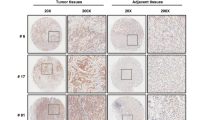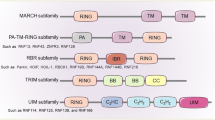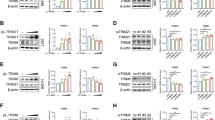Abstract
Accumulating data indicate that the ubiquitin–proteasome system controls apoptosis by regulating the level and the function of key regulatory proteins. In this study, we identified Trim17, a member of the TRIM/RBCC protein family, as one of the critical E3 ubiquitin ligases involved in the control of neuronal apoptosis upstream of mitochondria. We show that expression of Trim17 is increased both at the mRNA and protein level in several in vitro models of transcription-dependent neuronal apoptosis. Expression of Trim17 is controlled by the PI3K/Akt/GSK3 pathway in cerebellar granule neurons (CGN). Moreover, the Trim17 protein is expressed in vivo, in apoptotic neurons that naturally die during post-natal cerebellar development. Overexpression of active Trim17 in primary CGN was sufficient to induce the intrinsic pathway of apoptosis in survival conditions. This pro-apoptotic effect was abolished in Bax−/− neurons and depended on the E3 activity of Trim17 conferred by its RING domain. Furthermore, knock-down of endogenous Trim17 and overexpression of dominant-negative mutants of Trim17 blocked trophic factor withdrawal-induced apoptosis both in CGN and in sympathetic neurons. Collectively, our data are the first to assign a cellular function to Trim17 by showing that its E3 activity is both necessary and sufficient for the initiation of neuronal apoptosis.
Similar content being viewed by others
Log in or create a free account to read this content
Gain free access to this article, as well as selected content from this journal and more on nature.com
or
Accession codes
Abbreviations
- UPS:
-
ubiquitin–proteasome system
- CGN:
-
cerebellar granule neurons
- [KCl]o:
-
extracellular concentration of KCl
- K25:
-
serum-free medium containing 25 mM KCl
- K5:
-
serum-free medium containing 5 mM KCl
- PI3K:
-
Phosphatidyl Inositol-3-OH Kinase
- GSK3:
-
Glycogen Synthase Kinase 3
- SCG:
-
superior cervical ganglion
- NGF:
-
nerve-growth factor
- ML:
-
molecular layer
- P:
-
days after birth (post-natal)
- E:
-
days of embryonic development
- DIV:
-
days in vitro
- WT:
-
wild type
- GFP:
-
green-fluorescent protein
- ShRNA:
-
short hairpin RNA
- siRNA:
-
small interfering RNA
- BSA:
-
bovine serum albumin
References
Yuan J, Yankner BA . Apoptosis in the nervous system. Nature 2000; 407: 802–809.
Riedl SJ, Salvesen GS . The apoptosome: signalling platform of cell death. Nat Rev Mol Cell Biol 2007; 8: 405–413.
Youle RJ, Strasser A . The BCL-2 protein family: opposing activities that mediate cell death. Nat Rev Mol Cell Biol 2008; 9: 47–59.
Cross DA, Alessi DR, Cohen P, Andjelkovich M, Hemmings BA . Inhibition of glycogen synthase kinase-3 by insulin mediated by protein kinase B. Nature 1995; 378: 785–789.
Broemer M, Meier P . Ubiquitin-mediated regulation of apoptosis. Trends Cell Biol 2009; 19: 130–140.
Thompson SJ, Loftus LT, Ashley MD, Meller R . Ubiquitin-proteasome system as a modulator of cell fate. Curr Opin Pharmacol 2008; 8: 90–95.
Glickman MH, Ciechanover A . The ubiquitin-proteasome proteolytic pathway: destruction for the sake of construction. Physiol Rev 2002; 82: 373–428.
Pickart CM . Mechanisms underlying ubiquitination. Annu Rev Biochem 2001; 70: 503–533.
Canu N, Barbato C, Ciotti MT, Serafino A, Dus L, Calissano P . Proteasome involvement and accumulation of ubiquitinated proteins in cerebellar granule neurons undergoing apoptosis. J Neurosci 2000; 20: 589–599.
Sadoul R, Fernandez P-A, Quiquerez A-L, Martinou I, Maki M, Schröter M et al. Involvement of the proteasome in the programmed cell death of NGF-deprived sympathetic neurons. EMBO J 1996; 15: 3845–3852.
Desagher S, Severac D, Lipkin A, Bernis C, Ritchie W, Le Digarcher A et al. Genes regulated in neurons undergoing transcription-dependent apoptosis belong to signaling pathways rather than the apoptotic machinery. J Biol Chem 2005; 280: 5693–5702.
D'Mello SR, Galli C, Ciotti T, Calissano P . Induction of apoptosis in cerebellar granule neurons by low potassium: inhibition of death by insulin-like growth factor I and cAMP. Proc Natl Acad Sci USA 1993; 90: 10989–10993.
Ogawa S, Goto W, Orimo A, Hosoi T, Ouchi Y, Muramatsu M et al. Molecular cloning of a novel RING finger-B box-coiled coil (RBCC) protein, terf, expressed in the testis. Biochem Biophys Res Commun 1998; 251: 515–519.
Urano T, Usui T, Takeda S, Ikeda K, Okada A, Ishida Y et al. TRIM44 interacts with and stabilizes terf, a TRIM ubiquitin E3 ligase. Biochem Biophys Res Commun 2009; 383: 263–268.
Reymond A, Meroni G, Fantozzi A, Merla G, Cairo S, Luzi L et al. The tripartite motif family identifies cell compartments. EMBO J 2001; 20: 2140–2151.
Sardiello M, Cairo S, Fontanella B, Ballabio A, Meroni G . Genomic analysis of the TRIM family reveals two groups of genes with distinct evolutionary properties. BMC Evol Biol 2008; 8: 225.
Meroni G, Diez-Roux G . TRIM/RBCC, a novel class of ‘single protein RING finger’ E3 ubiquitin ligases. Bioessays 2005; 27: 1147–1157.
Miller TM, Tansey MG, Johnson EMJ, Creedon DJ . Inhibition of phosphatidylinositol 3-kinase activity blocks depolarization- and insulin-like growth factor 1-mediated survival of cerebellar granule cells. J Biol Chem 1997; 272: 9847–9853.
Bhat R, Xue Y, Berg S, Hellberg S, Ormo M, Nilsson Y et al. Structural insights and biological effects of glycogen synthase kinase 3-specific inhibitor AR-A014418. J Biol Chem 2003; 278: 45937–45945.
Cross DA, Culbert AA, Chalmers KA, Facci L, Skaper SD, Reith AD . Selective small-molecule inhibitors of glycogen synthase kinase-3 activity protect primary neurones from death. J Neurochem 2001; 77: 94–102.
Hongisto V, Smeds N, Brecht S, Herdegen T, Courtney MJ, Coffey ET . Lithium blocks the c-Jun stress response and protects neurons via its action on glycogen synthase kinase 3. Mol Cell Biol 2003; 23: 6027–6036.
Comella JX, Sanz-Rodriguez C, Aldea M, Esquerda JE . Skeletal muscle-derived trophic factors prevent motoneurons from entering an active cell death program in vitro. J Neurosci 1994; 14: 2674–2686.
Martin DP, Schmidt RE, DiStefano PS, Lowry OH, Carter JG, Johnson EMJ . Inhibitors of protein synthesis and RNA synthesis prevent neuronal death caused by nerve growth factor deprivation. J Cell Biol 1988; 106: 829–844.
Du Y, Bales KR, Dodel RC, Hamilton-Byrd E, Horn JW, Czilli DL et al. Activation of a caspase 3-related cysteine protease is required for glutamate-mediated apoptosis of cultured cerebellar granule neurons. Proc Natl Acad Sci USA 1997; 94: 11657–11662.
Wood KA, Dipasquale B, Youle RJ . In situ labelling of granule cells for apoptosis-associated DNA fragmentation reveals different mechanisms of cell loss in developing cerebellum. Neuron 1993; 11: 621–632.
Bobba A, Atlante A, Giannattasio S, Sgaramella G, Calissano P, Marra E . Early release and subsequent caspase-mediated degradation of cytochrome c in apoptotic cerebellar granule cells. FEBS Lett 1999; 457: 126–130.
Miller TM, Moulder KL, Knudson CM, Creedon DJ, Deshmukh M, Korsmeyer SJ et al. Bax deletion further orders the cell death pathway in cerebellar granule cells and suggests a caspase-independent pathway to cell death. J Cell Biol 1997; 139: 205–217.
Ham J, Babij C, Whitfield J, Pfarr CM, Lallemand D, Yaniv M et al. A c-Jun dominant negative mutant protects sympathetic neurons against programmed cell death. Neuron 1995; 14: 927–939.
Datta SR, Dudek H, Tao X, Masters S, Fu H, Gotoh Y et al. Akt phosphorylation of BAD couples survival signals to the cell-intrinsic death machinery. Cell 1997; 91: 231–241.
Brunet A, Bonni A, Zigmond MJ, Lin MZ, Juo P, Hu LS et al. Akt promotes cell survival by phosphorylating and inhibiting a Forkhead transcription factor. Cell 1999; 96: 857–868.
Gilley J, Coffer PJ, Ham J . FOXO transcription factors directly activate bim gene expression and promote apoptosis in sympathetic neurons. J Cell Biol 2003; 162: 613–622.
Whitfield J, Neame SJ, Paquet L, Bernard O, Ham J . Dominant-negative c-Jun promotes neuronal survival by reducing BIM expression and inhibiting mitochondrial cytochrome c release. Neuron 2001; 29: 629–643.
Putcha GV, Harris CA, Moulder KL, Easton RM, Thompson CB, Johnson Jr EM . Intrinsic and extrinsic pathway signaling during neuronal apoptosis: lessons from the analysis of mutant mice. J Cell Biol 2002; 157: 441–453.
Linseman DA, Butts BD, Precht TA, Phelps RA, Le SS, Laessig TA et al. Glycogen synthase kinase-3beta phosphorylates Bax and promotes its mitochondrial localization during neuronal apoptosis. J Neurosci 2004; 24: 9993–10002.
Knudson CM, Tung KS, Tourtellotte WG, Brown GA, Korsmeyer SJ . Bax-deficient mice with lymphoid hyperplasia and male germ cell death. Science 1995; 270: 96–99.
Towers E, Gilley J, Randall R, Hughes R, Kristiansen M, Ham J . The proapoptotic dp5 gene is a direct target of the MLK-JNK-c-Jun pathway in sympathetic neurons. Nucleic Acids Res 2009; 37: 3044–3060.
Arce V, Garces A, de Bovis B, Filippi P, Henderson C, Pettmann B et al. Cardiotrophin-1 requires LIFRbeta to promote survival of mouse motoneurons purified by a novel technique. J Neurosci Res 1999; 55: 119–126.
Lutfalla G, Uze G . Performing quantitative reverse-transcribed polymerase chain reaction experiments. Methods Enzymol 2006; 410: 386–400.
Xia Z, Dickens M, Raingeaud J, Davis RJ, Greenberg ME . Opposing effects of ERK and JNK-p38 MAP kinases on apoptosis. Science 1995; 270: 1326–1331.
Aalto AP, Sarin LP, van Dijk AA, Saarma M, Poranen MM, Arumae U et al. Large-scale production of dsRNA and siRNA pools for RNA interference utilizing bacteriophage phi6 RNA-dependent RNA polymerase. RNA 2007; 13: 422–429.
Swainson L, Mongellaz C, Adjali O, Vicente R, Taylor N . Lentiviral transduction of immune cells. Methods Mol Biol 2008; 415: 301–320.
Acknowledgements
This work was supported by the Centre National de la Recherche Scientifique (CNRS), the Institut National de la Santé et de la Recherche Médicale (INSERM), the Université Montpellier 2, the Fondation pour la Recherche Médicale (FRM), the Association pour la Recherche sur le Cancer (ARC) and the Wellcome Trust. We are grateful to the staff of the animal facilities of the IGMM for the breeding of mice and services in histology, the RIO imaging platform for technical assistance, the recombinant protein production facility of the IFR122 of Montpellier for the production and the purification of the Trim17 antibody and the vectorology platform of the IFR3 of Montpellier for technical assistance in the production of lentiviral particles. We thank Dr. I Allemand for the gift of Bax-deficient mice, Dr. O Coux for in vitro ubiquitination reagents and Dr. G Sczakiel for help in the definition of the siRNA no. 1 target sequence. We are grateful to Dr. J-C Martinou for critical reading of the article.
Author information
Authors and Affiliations
Corresponding author
Ethics declarations
Competing interests
The authors declare no conflict of interest.
Additional information
Edited by G Melino
Supplementary Information accompanies the paper on Cell Death and Differentiation website
Rights and permissions
About this article
Cite this article
Lassot, I., Robbins, I., Kristiansen, M. et al. Trim17, a novel E3 ubiquitin-ligase, initiates neuronal apoptosis. Cell Death Differ 17, 1928–1941 (2010). https://doi.org/10.1038/cdd.2010.73
Received:
Revised:
Accepted:
Published:
Issue date:
DOI: https://doi.org/10.1038/cdd.2010.73
Keywords
This article is cited by
-
The E3 ubiquitin ligase TRIM17 promotes gastric cancer survival and progression via controlling BAX stability and antagonizing apoptosis
Cell Death & Differentiation (2023)
-
Tripartite Motif Protein Family in Central Nervous System Diseases
Cellular and Molecular Neurobiology (2023)
-
Gene losses may contribute to subterranean adaptations in naked mole-rat and blind mole-rat
BMC Biology (2022)
-
TRIM17 and TRIM28 antagonistically regulate the ubiquitination and anti-apoptotic activity of BCL2A1
Cell Death & Differentiation (2019)
-
TRIM22-Mediated Apoptosis is Associated with Bak Oligomerization in Monocytes
Scientific Reports (2017)



